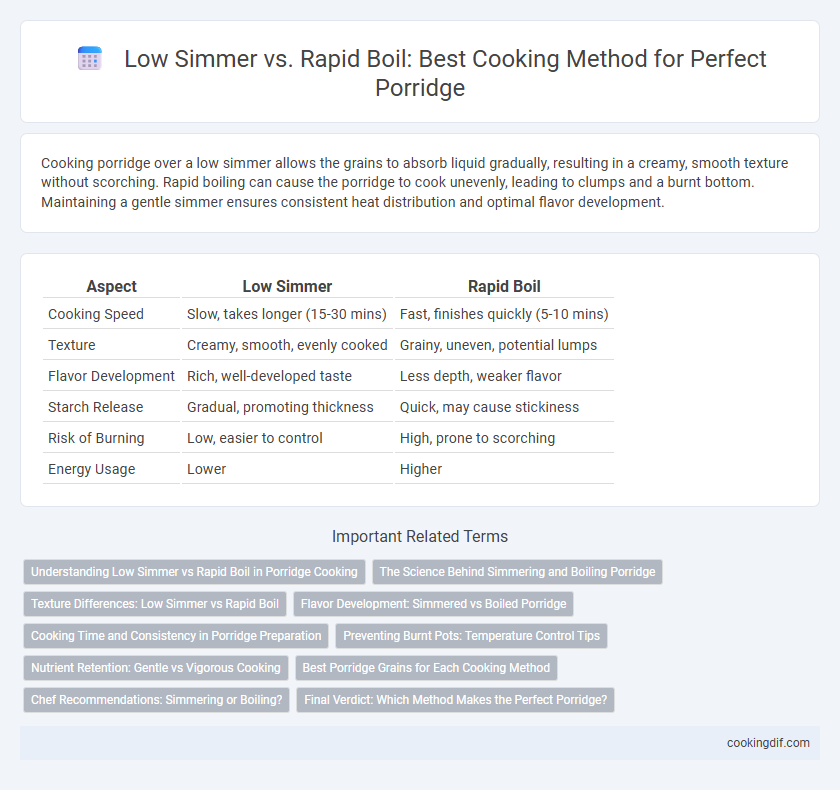Cooking porridge over a low simmer allows the grains to absorb liquid gradually, resulting in a creamy, smooth texture without scorching. Rapid boiling can cause the porridge to cook unevenly, leading to clumps and a burnt bottom. Maintaining a gentle simmer ensures consistent heat distribution and optimal flavor development.
Table of Comparison
| Aspect | Low Simmer | Rapid Boil |
|---|---|---|
| Cooking Speed | Slow, takes longer (15-30 mins) | Fast, finishes quickly (5-10 mins) |
| Texture | Creamy, smooth, evenly cooked | Grainy, uneven, potential lumps |
| Flavor Development | Rich, well-developed taste | Less depth, weaker flavor |
| Starch Release | Gradual, promoting thickness | Quick, may cause stickiness |
| Risk of Burning | Low, easier to control | High, prone to scorching |
| Energy Usage | Lower | Higher |
Understanding Low Simmer vs Rapid Boil in Porridge Cooking
Cooking porridge at a low simmer ensures even heat distribution, preventing the oats from sticking to the pan and resulting in a creamy, smooth texture. Rapid boiling creates vigorous bubbles that can cause uneven cooking, scorched spots, and a grainy consistency. Maintaining a gentle low simmer is essential for achieving the ideal porridge consistency and flavor development.
The Science Behind Simmering and Boiling Porridge
Simmering porridge allows starch granules to swell gradually, promoting a creamy texture as the heat breaks down starch molecules evenly, whereas rapid boiling causes vigorous agitation that can rupture these granules, resulting in a lumpy and uneven consistency. Maintaining a low simmer ensures optimal gelatinization of starch, maximizing both flavor absorption and nutrient retention in grains such as oats or rice. Scientific studies in food chemistry highlight that controlled heat application during simmering reduces molecular disruption, enhancing the porridge's digestibility and mouthfeel compared to the chaotic thermal environment of a rapid boil.
Texture Differences: Low Simmer vs Rapid Boil
Cooking porridge at a low simmer produces a creamy, smooth texture as the gentle heat allows starch granules to swell gradually, preventing clumping and sticking. In contrast, rapid boiling agitates the grains more aggressively, often resulting in a thicker, lumpier texture and a tendency for the porridge to scorch on the pot's surface. Maintaining a low simmer is key for achieving the ideal soft consistency and preventing grain breakdown during cooking.
Flavor Development: Simmered vs Boiled Porridge
Low simmering porridge enhances flavor development by allowing starches to break down gradually, creating a creamier texture and deeper, maltier taste. Rapid boiling causes starch granules to burst quickly, resulting in a thinner consistency and less nuanced flavor profile. Slow cooking supports Maillard reactions and caramelization, intensifying natural sweetness and aroma in porridge.
Cooking Time and Consistency in Porridge Preparation
Low simmering porridge ensures a longer cooking time, allowing oats to absorb liquid gradually and achieve a creamy, smooth consistency without breaking down. Rapid boiling shortens the cooking duration but often causes uneven texture and a risk of burning or sticking to the pot. Maintaining a low simmer optimizes porridge preparation by balancing cooking time and producing a desirable, uniform consistency.
Preventing Burnt Pots: Temperature Control Tips
Cooking porridge over a low simmer ensures even heat distribution, preventing the formation of burnt residue on the pot's surface. Rapid boiling creates intense heat that can scorch the grains, leading to stubborn burnt patches and an unpleasant taste. Maintaining a gentle simmer with frequent stirring significantly reduces the risk of burnt pots and preserves the porridge's creamy texture.
Nutrient Retention: Gentle vs Vigorous Cooking
Cooking porridge on a low simmer preserves heat-sensitive nutrients such as B vitamins and antioxidants by minimizing exposure to high temperatures. Rapid boiling causes vigorous agitation and intense heat, which can break down delicate nutrients and reduce the overall nutritional value. Maintaining a gentle simmer ensures optimal nutrient retention while achieving a creamy texture in porridge.
Best Porridge Grains for Each Cooking Method
Low simmer cooking preserves the delicate texture of oats and quinoa, making it ideal for steel-cut oats and hulled barley that require longer cooking times to soften without breaking down. Rapid boil suits instant oats and rolled oats, which benefit from quick heat to achieve a creamy consistency swiftly without sacrificing flavor. Choosing the right grain based on the cooking method ensures optimal porridge texture and nutrient retention.
Chef Recommendations: Simmering or Boiling?
Chefs recommend simmering porridge at a low heat to ensure even cooking and prevent burning, preserving a creamy texture and maximizing flavor. Rapid boiling can cause the grains to become tough and sticky, leading to uneven consistency and risking overflow. Maintaining a gentle simmer allows the starches to gradually release, resulting in a smoother and more palatable porridge.
Final Verdict: Which Method Makes the Perfect Porridge?
Cooking porridge at a low simmer ensures even heat distribution, resulting in a creamy texture and preventing the grains from sticking or burning. Rapid boiling creates a harsher environment that can cause uneven cooking and a lumpy consistency. For the perfect porridge, maintaining a low simmer is the recommended method to achieve smoothness and optimal flavor absorption.
Low simmer vs rapid boil for porridge cooking method Infographic

 cookingdif.com
cookingdif.com